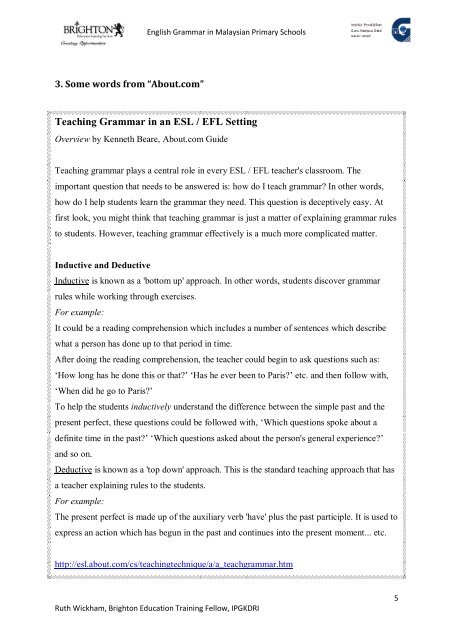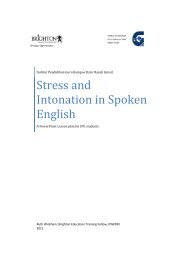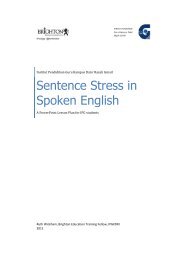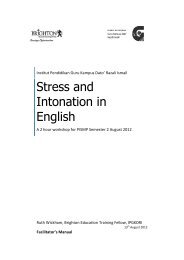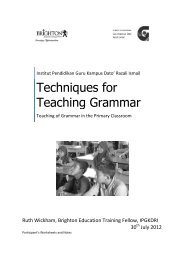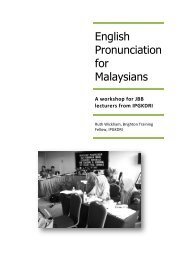Teaching English Grammar in Malaysian Primary Schools
Teaching English Grammar in Malaysian Primary Schools
Teaching English Grammar in Malaysian Primary Schools
Create successful ePaper yourself
Turn your PDF publications into a flip-book with our unique Google optimized e-Paper software.
<strong>English</strong> <strong>Grammar</strong> <strong>in</strong> <strong>Malaysian</strong> <strong>Primary</strong> <strong>Schools</strong>3. Some words from “About.com”<strong>Teach<strong>in</strong>g</strong> <strong>Grammar</strong> <strong>in</strong> an ESL / EFL Sett<strong>in</strong>gOverview by Kenneth Beare, About.com Guide<strong>Teach<strong>in</strong>g</strong> grammar plays a central role <strong>in</strong> every ESL / EFL teacher's classroom. Theimportant question that needs to be answered is: how do I teach grammar? In other words,how do I help students learn the grammar they need. This question is deceptively easy. Atfirst look, you might th<strong>in</strong>k that teach<strong>in</strong>g grammar is just a matter of expla<strong>in</strong><strong>in</strong>g grammar rulesto students. However, teach<strong>in</strong>g grammar effectively is a much more complicated matter.Inductive and DeductiveInductive is known as a 'bottom up' approach. In other words, students discover grammarrules while work<strong>in</strong>g through exercises.For example:It could be a read<strong>in</strong>g comprehension which <strong>in</strong>cludes a number of sentences which describewhat a person has done up to that period <strong>in</strong> time.After do<strong>in</strong>g the read<strong>in</strong>g comprehension, the teacher could beg<strong>in</strong> to ask questions such as:‘How long has he done this or that?’ ‘Has he ever been to Paris?’ etc. and then follow with,‘When did he go to Paris?’To help the students <strong>in</strong>ductively understand the difference between the simple past and thepresent perfect, these questions could be followed with, ‘Which questions spoke about adef<strong>in</strong>ite time <strong>in</strong> the past?’ ‘Which questions asked about the person's general experience?’and so on.Deductive is known as a 'top down' approach. This is the standard teach<strong>in</strong>g approach that hasa teacher expla<strong>in</strong><strong>in</strong>g rules to the students.For example:The present perfect is made up of the auxiliary verb 'have' plus the past participle. It is used toexpress an action which has begun <strong>in</strong> the past and cont<strong>in</strong>ues <strong>in</strong>to the present moment... etc.http://esl.about.com/cs/teach<strong>in</strong>gtechnique/a/a_teachgrammar.htmRuth Wickham, Brighton Education Tra<strong>in</strong><strong>in</strong>g Fellow, IPGKDRI5


